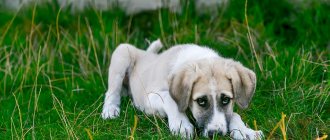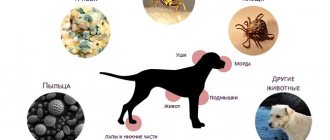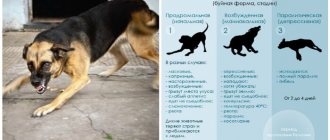A seizure is a symptom of several dangerous diseases in pets. Convulsions in a dog throughout the body look frightening and entail serious consequences: pets drool, lose consciousness, and their muscles go into spasm. Treatment usually consists of identifying the cause and treating the symptoms; after this comes specific therapy that eliminates the cause of the disease (if possible).
How do seizures manifest?
Excessive activity in the motor parts of the brain increases the likelihood of seizures in dogs. It is important to understand that seizures can be different: they are expressed as involuntary twitching of the limbs or as a severe attack in which the dog loses consciousness. It depends on how large an area of the brain is affected by the disease.
What is a cramp
A cramp is a muscle contraction that occurs involuntarily, that is, without the participation of consciousness. The muscles become tense and sometimes even deformed. Very often the process is accompanied by severe pain.
Externally, convulsions can be noticeable or invisible - it all depends on the severity of the attack. The animal's muscles may contract very weakly, but the pet will whine and behave strangely.
Types of spasms
There are four types of spasms. They all have specific causes, duration and intensity. What each of them looks like and what causes it:
- Convulsions
– frequent contractions of a small muscle group while maintaining clarity of consciousness. Muscle contractions continue from a few seconds to two to ten minutes. Sometimes they cause pain. Convulsions occur with head injuries, poisoning, sudden increases in temperature, and neurological disorders.
- Tonic convulsions
. These are mild spasms in which large muscles are not involved or only one of them is involved. The pet does not lose consciousness, but whines in pain. Lost in familiar surroundings. Tonic convulsions in a dog look like single twitches of the limbs at regular intervals. A seizure can be triggered by metabolic disorders (due to viruses, including rabies, severe poisoning or diabetes), cardiovascular problems, hypothermia, stress or overexcitement, kidney or liver failure.
- Clonic
- these are fast, short-term, sometimes rhythmic contractions and relaxations. This often impairs coordination and prevents normal walking. Seizures are short-lived, lasting from 30 seconds to several minutes. Barbosa quickly lets go, he tries to get to his feet, but at the same time he is disoriented. A new attack will soon follow. Causes may include stress, excessive physical activity, infectious diseases, traumatic brain injuries, tumors, etc.
- Epileptic seizures
– the whole body of the animal twitches, and saliva flows from the mouth. The dog is unconscious. During attacks, she closes her eyes or keeps them wide open. The cause of epileptic seizures is clear from the name - the dog has congenital or acquired epilepsy. These seizures in dogs usually cannot be treated, but they can be minimized and alleviated.
If spasms affect only some muscle groups, they are called localized. Muscle contraction throughout the body is classified as a generalized type.
The consequences of the first three types of hypertonicity in dogs are considered mild relative to epileptic ones. But if you leave everything to chance, don’t diagnose it and don’t start treatment, the dog will get worse and worse.
First aid for a pet
The occurrence of seizures in a pet should not cause the owner to stop. For example, muscle contractions and drooling may indicate the presence of worms. The symptoms are not so much scary as the consequences. During an attack, the dog can be seriously injured.
First of all, the animal needs to be provided with complete rest. Loud sounds and bright lights should be avoided. You should not put your pet on the bed; it is better to move it onto a thick cloth. Turn your dog over on his right side to make breathing easier and allow foam to come out of his mouth to prevent the pet from choking.
Since convulsions can be accompanied by a concussion of the head, to avoid head injuries, place a thick cushion under the animal’s head. Unclenching the jaws and forcefully pushing the spoon through is strictly prohibited. It is not recommended to restrain your dog if it is wandering and wants to leave.
If an animal experiences cramps in its hind legs, then you need to wrap the pet in a warm blanket and take it to a veterinary clinic. The dog owner should record the pet's seizures and note the duration, symptoms and severity.
Who is at risk?
Seizures are most often observed in small breed dogs. This is explained by their tendency to low blood glucose levels, and, accordingly, to hypoglycemic attacks. Also, miniature individuals more often suffer from eclampsia - a sharp increase in blood pressure.
Males are more susceptible to seizures: males are much more prone to epilepsy and neurological disorders than females.
This disease is common in collies, dachshunds, poodles, Labradors, huskies, and boxers. These breeds are at increased risk of congenital or acquired epilepsy.
Stages and symptoms of seizures in dogs
Owners, especially beginners, are not always able to recognize the initial stage of an approaching seizure. If this is not the first time that a dog has had seizures, it is easier to notice them and provide first aid. Typically an attack is divided into three stages:
- Aura
- the time when the approach of seizures is noticeable. The dog behaves restlessly, the limbs and tail begin to shake a little. The aura can be short-term - from a few minutes - or long-lasting. In some cases it takes 2-3 days.
- Main Impact
. Characterized by foaming at the mouth and seizures in the dog. The pet does not move its paws, falls, its mouth becomes covered with saliva or foam, and involuntary urination is acceptable.
- Post-traumatic stage
- the time when the seizure just ended. The animal is disoriented, absent-minded, whining from a headache. This continues from an hour to a day.
It is important to notice the onset of an attack at the initial stage - this way you will have more time to provide all possible assistance and protect you from unpleasant consequences. Record the time when the attack began and ended. You will then provide this information to your veterinarian.
Treatment
Before diagnosing the causes, a specialist will begin treating a dog’s seizure with intramuscular injections of magnesium sulfate. This is an antihistamine that will stop spasms and eliminate attacks of involuntary muscle contractions. Then the doctor will study the symptoms, send the animal for examination and only after that, based on the results, make an accurate diagnosis and prescribe the necessary treatment. You only need to strictly follow all the doctor’s recommendations until your pet recovers completely.
The main mistake made by many dog owners is to stop treatment without permission when they believe that their pet has already recovered and that there is no need to “poison” it with medications again. This cannot be done; the animal must undergo a full course of treatment, which can only be completed with the permission of the doctor. And it depends only on the dog’s owner whether his four-legged friend will fully recover. After all, treatment of a pet often takes place at home, and if you disregard the specialist’s recommendations, the health and even the life of the pet will be at risk.
Causes of seizures in dogs
Spasms, especially recurring ones, are a sign of many serious illnesses. Stopping them does not indicate that the disease has subsided - the dog still requires treatment.
Only in some cases can a 1-2 attack be harmless and not indicative of any disease - this is trembling in a dream, at a veterinarian’s appointment, etc.
Diseases as the root cause
Tonic and clonic convulsions should alert the owner - the dog clearly needs diagnosis from a specialist. Seizures may recur until the root cause is eliminated.
Common causes of seizures in dogs:
- Infection
. Bacteria or viruses pose a serious threat to the animal's central nervous system. The most striking examples of such diseases are rabies, enteritis, leptospirosis and meningitis. Each of these diseases is deadly, so you need to take care of your dog's vaccinations.
- Intoxication of the body
. In other words, poisoning by poisons, saliva from the bite of a dangerous insect or snake. Usually, when an animal is poisoned, accompanying symptoms appear: vomiting, diarrhea, intestinal spasms, fever, and consumption of large amounts of water. Salvation is timely detoxification, gastric lavage or administration of an antidote.
- Spinal injuries or concussions
. Seizures begin even months or years after injury.
- Heart diseases
also sometimes cause seizures.
- Cancer
spinal cord or brain.
- Nervous system infection
, such as, for example, distemper, becomes a provocateur of hypertonicity and subsequent failure of the hind limbs.
The most common cause is epilepsy. It is possible to diagnose this disease at a young age, since this pathology is most often congenital in nature.
Non-hazardous factors
If your puppy twitches his paws while sleeping, don't be alarmed. These are not spasms in the full sense - most likely, the baby is dreaming about something. The exact same situation can occur in adult dogs.
The nervous system of young animals is quite excitable, so seizures in a puppy can be caused by simple overexcitation. Pay more attention to your baby, go for walks in new places more often and engage in active games.
Another cause of seizures in a dog can be nervous tension, when trembling turns into spasms. This can often be noticed when visiting a veterinary clinic and during unpleasant procedures: injections, removal of sutures, etc. Particularly sensitive dogs flinch strongly at loud, sharp sounds.
Muscle hypertonicity occurs after anesthesia - in this case, it would not be superfluous to consult a veterinarian, at least by phone. In most cases, this does not pose any danger, but it is better to be on the safe side.
After giving birth to a bitch
Seizures after giving birth in a dog are called postpartum eclampsia. It manifests itself as a strong spasm against the background of high blood pressure, while the pet is conscious. The cause of eclampsia in a young mother may be:
- deficiency of protein and vitamins;
- severe calcium deficiency;
- poisoning – new or low-quality food can cause harm;
- intoxication from rotting of the remains of the placenta or lochia (postpartum discharge).
Any of the reasons requires contacting a veterinarian. As a rule, eclampsia manifests itself 2 weeks after birth, much less often - immediately after whelping or in the last day of gestation.
Causes
Seizures in dogs have reasonable causes. This is a visible manifestation of the disease. Only a qualified veterinarian can establish a connection between muscle spasms and disease, but every owner should be aware of diseases with such manifestations.
- Eclampsia. The disease occurs due to a lack of calcium in the body. Animals of small breeds weighing up to 5 kg are most often affected. Pregnant and lactating bitches are especially susceptible. The result of a long-term lack of calcium in the blood is convulsions.
- Hypoglycemia and hyperglycemia - there is not enough glucose in the blood or there is an excess. Both are deviations from the norm that cause metabolic disorders. Kidneys and liver suffer. When neglected, it leads to serious damage to internal organs and the brain. The disease can be hereditary and acquired as a result of an improper diet.
- Intoxication of the body caused by any reason - poisoning, bites of poisonous animals, insects, advanced disease - is also the cause of seizures. One of them is hyperammonemia - dysfunction of the kidneys. The body poisons itself with untimely elimination of the breakdown products of substances.
- Injuries to the spine, head, internal organs.
- Infectious diseases are a common cause of uncontrolled convulsions. Dangerous to humans - rabies.
Epilepsy, as a cause of prolonged, painful seizures, deserves separate consideration. It occurs due to disturbances in the functioning of the brain due to a tumor, injury, inflammation, previous or untreated infectious disease, or heredity.
Epilepsy is in most cases a genetic disorder. Therefore, pets suffering from this disease are not recommended to reproduce. Next, there are acquired causes that affect the brain:
- Intoxication.
- Plague, toxoplasmosis, tetanus.
- Snake and insect bites.
- Helminths.
- Skull injuries.
- Malnutrition.
- Kidney diseases, cirrhosis.
- Diabetes.
- Hypovitaminosis.
- Mineral deficiency.
- Arrhythmia, brain cancer.
- Electric shock.
Often, due to inexperience, seizures are confused with a drunken gait of an animal, the cause of which is degenerative myelopathy. Rhythmic twitching during sleep is normal for puppies. And old dogs can tremble in their sleep and even whine. However, this is also a normal phenomenon and is completely different from painful cramps.
Diagnosis and treatment
A veterinarian must determine the cause and prescribe treatment for seizures in a dog. Until then, the owner can only alleviate the dog’s plight and help it avoid injury.
What to do if your dog has seizures: first aid at home
Obviously, if your dog starts having seizures, it needs to be seen by a doctor. But it may be impossible to do this instantly - in such cases, the owners will be helped by a first aid plan for seizures in a dog:
- Look carefully at which muscles are affected by the disease: is the whole body twitching or are only some areas affected? Pay attention to whether the dog has lost consciousness or not. All this will need to be told to the doctor during the examination.
- Move your pet to the floor if the seizure begins on a sofa, bed, or any other elevated surface. Place a low pillow or soft towel under your neck and head to avoid injury and choking on saliva.
- Turn the animal onto its right side.
- A dog is not a person, so do not put your fingers or any other foreign objects into its mouth. During a spasm, the animal will not swallow its tongue - this is a physiological feature.
- Don't shout, get rid of all sources of noise (TV, radio, music). Loud sounds will only aggravate the patient's condition.
- If the veterinarian agrees (during a telephone consultation), give the animal an injection of magnesium sulfate - it will quickly stop the spasm.
- Do not feed the dog immediately after an attack, but rather give it a good drink. If the victim has difficulty swallowing, give them an ice cube to lick.
- Do not use serious drugs like Phenobarbital or Diazepam without your doctor's permission. Strong medications if prescribed incorrectly will only worsen the situation.
If possible, measure the dog's temperature, but only after an attack - during the trembling, the pet can break the thermometer and get hurt.
Place the injured dog on soft bedding or a towel, away from sharp corners. If the animal continually tries to run away, hide, or simply move around the house randomly, place it on a bedding with high sides, a basket, or at least a tall cardboard box so that the pet does not get out. Stay close to him all the time, monitor his condition.
During a trip to the doctor, the dog should be wrapped in a warm blanket and held in your arms in case another attack comes.
Examination and diagnosis
Only a veterinarian has the right to prescribe the correct, precise treatment for a dog. He will take all the necessary tests and determine the root cause of the seizures. Do not delay your visit to him, especially if:
- the dog suffers from prolonged attacks lasting more than 10 minutes;
- the animal is unconscious during attacks;
- even before the onset of seizures, the pet seems sick (he has diarrhea, heavy breathing, changes in behavior, vomiting);
- attacks occur more often than twice a day;
- your pet is less than 1 or more than 10 years old.
As soon as you bring your dog to the clinic, the doctor will administer antiallergy medications. This is completely harmless and in some cases will help the animal: eliminate spasms, relieve pain.
Only after this the veterinarian will begin the examination. Be sure to tell us about all your observations and answer questions clearly - the health and life of your pet depends on it.
Upon arrival at the hospital, you must take a blood and urine test, as well as carry out the following procedures:
- ECHO, MRI/CT and ultrasound;
- X-ray;
- examination by a neurologist.
The doctor will prescribe medications to the animal and carry out all the necessary procedures, depending on the identified cause of the problem. Then you will know what your pet is sick with and whether he will be able to fully recover. Most likely, you will have to continue treatment at home on your own, while following all medical recommendations and prescriptions.
Treatment regimen
Upon returning from the hospital, provide your dog with a quiet place to rest, nutritious food, water and necessary medications. Treatment methods will depend entirely on what caused the muscle hypertonicity.
Epilepsy
There is no cure, but attacks can be significantly reduced and alleviated. Many owners are afraid of living with such a dog and put the animal to sleep, but in reality there is nothing super scary. If you give your pet the prescribed medications on time and monitor his health, then attacks will recur very rarely. In this case, the pet can live a good and long life.
Viruses
are treated with a whole range of drugs: antiviral, immunostimulating, antibiotics, anti-inflammatory, symptom-relieving (antiemetic, anticonvulsant, etc.). Therapy takes a long time, but if successful, the dog is completely cured.
Head and spine injuries
are treated strictly individually, depending on the location and strength of the lesion. Tumors are treated surgically; in advanced cases, the doctor may recommend euthanasia.
Severe stress
requires a set of measures taken by the owner: increased attention and communication with the pet, frequent walks, creating a calm atmosphere in the house. In difficult cases, the doctor will prescribe sedatives - you cannot give them to the dog yourself, as it can cause an allergy.
Treatment of poisoning
begins with powerful detoxification and subsequent replenishment of water and electrolyte balance. Probiotics and a special diet will not hurt.
Postpartum eclampsia
involves adjusting the diet, including protein and calcium. If eclampsia is caused by intoxication of the undelivered placenta, surgery may be necessary.
Diabetes
requires strict menu planning and adherence to it. Any deviation from the rules can lead to a hypoglycemic attack and even coma.
First aid
If suddenly your pet begins to experience involuntary muscle contractions, the main thing is not to be scared and try to alleviate the dog’s condition as much as possible. Unfortunately, it is impossible to help your pet in this situation, since convulsive twitching is a very serious symptom. Then what should you do if your dog has seizures? The first action is to immediately call a veterinarian or, if possible, take your pet to the clinic. Don’t panic, especially since you can help your pet, even if it’s insignificant.
Provide the animal with peace and quiet, darken the windows, and then carefully (during periods of relaxation) transfer the dog to a bedding or thick mattress (but not to the bed). Do not perform any manipulations with the pet and do not try to restrain it or otherwise bring it to its senses; this is strictly forbidden. Only a qualified specialist can provide the necessary medical care to an animal. The only thing you are allowed to do on your own (if you do not dare to carry your pet) is to lightly hold the dog so that it does not hit its head on foreign objects.
Carefully monitor the animal’s condition, pauses between attacks, and the dog’s behavior in general. You will need to tell your doctor about all your observations for correct diagnosis and the most effective treatment. Another action that veterinarians recommend as first aid if a dog has convulsions throughout the body is to carefully drop a few drops of Corvalol or Valocordin onto the pet’s tongue. These drugs will calm your pet a little and reduce the excitability of the nervous system.
Prevention and precautions
An integral part of caring for your pet’s health is the timely administration of all vaccinations. It is important to stay on schedule and not miss vaccination dates.
Meals should be organized in accordance with the dog’s age, breed and physical activity. Inexperienced owners should definitely consult a veterinarian or dog handler - in extreme cases, a breeder with a lot of knowledge.
Animals at risk need to be monitored by a veterinarian: regularly donate blood and urine, do ultrasound and other tests, depending on which system is weakened.
For healthy dogs, the attention of the owner is important - at the slightest change in behavior, it is necessary to begin observation, take notes and contact a veterinarian within 24 hours.
The main reason that the dog never recovers is the negligence of the owners and neglect of the doctor’s recommendations. Convulsive seizures in an animal are a serious problem, and you cannot deviate from the prescribed treatment, relying on your own guesses. Only the so-called sleep convulsions in dogs are safe - these are natural trembling of the limbs during dreams. Everything else requires attention and treatment.
The article is for informational purposes only. Contact your veterinarian!
Prevention
Veterinarians recommend preventive measures that do not guarantee, but reduce the likelihood of disease.
- Balanced diet; This measure looks like a general recommendation, but its importance does not diminish. Nutrient imbalances are always dangerous. In this case, you should pay attention to the amount of glucose and calcium in the pet’s body.
- Avoiding contact with household chemicals, as well as toxic substances that can easily be found on the street.
- Walking on a leash is recommended if the area is unfamiliar and not fenced; It is important to remember that if the dog becomes confused after an attack, it may run away.
- Regular scheduled vaccinations.











